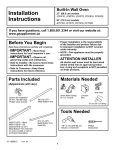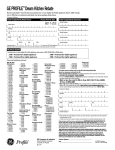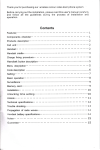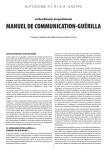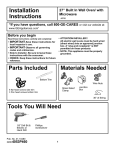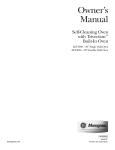Download GE Profile JT980 Electric Double Oven
Transcript
Installation Instructions 30” Built-In Trivection™ Wall Oven JT930, JT980, ZET3038, ZET3058 Questions? Call 800.GE.CARES (800.432.2737) or Visit our Website at: www.GEAppliances.com BEFORE YOU BEGIN FOR YOUR SAFETY: Read these instructions completely and carefully. • Be sure your oven is installed properly by a qualified installer or service technician. • Be sure the oven is securely installed in a cabinet that is firmly attached to the house structure. Weight on the oven door could cause the oven to tip and result in injury. Never allow anyone to climb, sit, stand or hang on the oven door. • Make sure the cabinets and wall coverings around the oven can withstand the temperatures (up to 200°F) generated by the oven. • IMPORTANT • IMPORTANT • • • • • • — Save these instructions for local inspector’s use. — Observe all governing codes and ordinances. Note to Installer – Be sure to leave these instructions with the Consumer. Note to Consumer – Keep these instructions for future reference. Skill level – Installation of this appliance requires basic mechanical and advanced electrical skills. Completion time – 1 to 3 hours Proper installation is the responsibility of the installer. Product failure due to improper installation is not covered under the Warranty. WARNING: The electrical power to the oven supply line must be shut off while line connections are being made. Failure to do so could result in serious injury or death. • To prevent damage to the door and to prevent excessive microwave leakage, do NOT remove the door on the single wall oven or the upper oven door on the double wall oven. WARNING — This appliance must be properly grounded. • ATTENTION INSTALLER All electric wall ovens must be hard wired (direct wired) into an approved junction box. A plug and receptacle is NOT permitted on these products. 229C4053P546-2 31-10557-2 04-04 JR 1 Installation Instructions PREPARE TO INSTALL THE OVEN TOOLS YOU WILL NEED PARTS INCLUDED Metal Bottom Trim Drill with 1/8” Bit (Extension may be required) Safety Glasses 12 Screws Plastic Bottom Trim Straight Edge or Square Adjustable Wrench (for 1-7/16” Nut) OR Pencil Phillips Screwdriver Metal Bottom Trim Assembly Level Tape Measure Gloves Hand or Sabre Saw MATERIALS YOU MAY NEED Strain Relief Clamp for 1/2” conduit Junction Box Wire Nuts 60” of String for Single Ovens 96” of String for Double Ovens 2 Installation Instructions 1 PRE-INSTALLATION 1 PRE-INSTALLATION (CONT.) All installation information on the following pages is to be used for SINGLE and DOUBLE oven installation! A NOTE: To prevent damage to the door and to prevent excessive microwave leakage, do NOT remove the door on single wall oven models or the upper oven door on double wall oven models. Remove packaging materials. Check behind hinges. Remove plastic on trims and panel, all tape around the oven and any shipping screws securing the oven to the base pad. Use caution when lifting the oven forward; the ovens are front heavy. E The lower oven door on the double wall oven may be removed as an added convenience during installation. See Step 4. DO NOT LIFT THE OVEN BY THE HANDLE! Oven Racks EASY INSTA LLAT EASY INSTALLATION OF IONYOUR NEW 30" OF WAOVEN 30" WALL LL OV YOUR NEW EN Broiler Pan and Grid Befo re IMPO you begin -Read IMPO RTANTSave these Note RTANTto Insta OBSE these instruinstru OWN ction Before you begin-Read completely RVE instructions ller- these ERs compand carefully. ALL ctions Be instructions Note Keep IMPORTANTfor local inspector’s use. - ThisSave these these sure to GOVERNIfor local letely and leave appli inspe IMPORTANT- OBSERVE ALL GOVERNING CODES AND ORDIANCES. ance instruction these NG COD ctor’s carefully. Note to Installer- Be suremust to leave these with the consumer. instru ES s forinstructions use. AND be prop ction futur OWNER- Keep these instructions for future reference. e refer s withORDIANC erly FOR grou Note- This appliance must be properly grounded (if ence applicable). ES. the YOUR nded cons . SAFE umer (if appli Befo TY . re cable instru you begin ). -Read caref ctions comp ully. ELECTRICAL REQUIREMENTS IMPO FOR YOUR SAFETY letely these and ELEC instru RTANTTRIC Save ction you begin-Read these IMPOBefore AL REQU these Before you begin-Read these RTAN s for local Befo completely and GOV instructions instructions completely and IREM re ERNI T- OBSE inspe instru you begin ENTS Note carefully. ctor’s NG carefully. RVE -Read caref ctions use. ALL IMPORTANTSave these Insta CODES these to compSave these IMPORTANTully. AND llerIMPO instru letely these for local inspector’s use. OWN instructions instructions for localand inspector’s use. ction Be sure ORDIANC ERinstru RTANTto leave OBSERVE ALL ES. for futur IMPORTANTKeep s with Save OBSERVE ALL IMPORTANTthe AND ORDIANCES. IMPO ction these CODES these s for eGOVERNING Note refer GOVERNING instru cons localCODES AND ORDIANCES. umer ence GOV RTAN Tprop ThisNote to Installer- Be sure to leave ction inspe ERNI . Note toOBSE InstallerBe ctor’s sure to leave erly appliance. s Note NG RVE grou these instructions with the consumer. Befo these COD instructions with theuse. consumer. nded must re these to Insta ES ANDALL be ller- Keep instru youOWNERKeep begin (if OWNERinstructions applithese instructions Be surethese OWN instru ORD cable -Read caref ctionsfor future reference. IANC ER- forction future reference. comp to leave s with ). for futur Keep ully. these ES. IMPO letelyappliance Note- This must be the Note-these This appliance e refer Note consmust be and instru instru RTANT-properly grounded (if applicable). prop - This properly umer ence grounded (if applicable). Save ction . . IMPO ctions Beforethese erly appli s these anceyou begin-Read for local you begin-Read these grouBefore Befo GOV RTANT- instructions nded must re instructions and ERNI OBSE inspe completely and be instru you begin (if applicompletely Note ctor’s NG carefully. COD RVE ALL -Read cable caref ctions carefully. use. these to Insta comp ES ully. ). Save these AND ller-IMPORTANTIMPO IMPORTANTSave these letely these OWN instruction Be sure ORD andfor local inspector’s use. instructions forIANC local inspector’s instru use. RTAN ERinstructions T- Save to leave for futur Keep s with ES. ALL IMPORTANTOBSERVE IMPO ctions the IMPORTANTOBSERVE ALL these e refer these Note for local instru consCODES GOVERNING GOV RTANTumer AND ORDIANCES. GOVERNING CODES AND ORDIANCES. prop This applience. ction ERNI OBSE inspe erly Note to InstallerNote ctor’s Be sure to leave s Be. sure to leave NG to InstallerRVE grou ance must CODNote use. ALL nded these instructions with the consumer. these to Insta ES AND instructions with the consumer. ller- these (if appli be OWN instruction BeOWNEROWNERKeep these instructions Keep these instructions sure ORD cable IANC ERto leave for futur Keep s with ). for future reference. ES. for future reference. the these e Note cons refer Note- This appliance must be Noteappliance must be instruThis umer prop This applience. ction properly grounded (if applicable). . (if applicable). properly grounded erly s grou ance must nded (if appli be cable ). Literature Pack B Open oven door and remove literature pack, broiler pan and grid and oven racks. C Remove Installation Instructions from literature pack and read them carefully before you begin. D Be sure to place all literature, Owner’s Manual, Installation Instructions, etc. in a safe place for future reference. 3 F Place the oven on a table or platform even with the cutout opening. (Platform must support 225 lbs. single, 375 lbs. double.) G Remove the bottom trim from the top of the oven. It will be installed at the end of the installation process. Installation Instructions SINGLE BUILT-IN OVEN CUTOUT OPTIONS 2 CUTOUT OPTIONS FOR SINGLE BUILT-IN OVENS A NOTE: If the cabinet does not have a front frame and the sides are less than 3/4” thick, shim both sides equally to establish the cutout width. Skip to Step 3 for Double Built-In Oven models. There are 4 installation options for single built-in ovens. Choose the appropriate one for your application: A WALL MOUNT—SINGLE BUILT-IN OVEN OPTION B WALL MOUNT—SINGLE BUILT-IN OVEN BELOW AN ADVANTIUM™ OVEN OPTION C WALL MOUNT—SINGLE BUILT-IN OVEN ABOVE A WARMING DRAWER OPTION D UNDER COUNTER—SINGLE BUILT-IN OVEN OPTION A WALL MOUNT—SINGLE BUILT-IN OVEN OPTION 3 1/2” Cutout Width 28 1/2” Min 28 5/8” Max. All corners must be cut square Allow 11/16” on sides for overlap of oven beyond cutout If the cabinet does not have a solid bottom, two braces or runners must be installed level with the bottom of the cutout to support the weight of the oven. For single ovens, the runners and braces must support 225 lbs. The solid bottom or runners must be level with the bottom of the cutout, or the bottom trim may not install correctly and then interfere with the door opening. CL 7” Required Junction Box Area Opening between inside walls must be at Least 28 1/2” Wide Suitable Bracing to Support Runners 21 5/8” Over Centerline of Cabinet 6” Cutout Height 27 1/4” Min. 27 5/16” Max. NOTE: This oven is not approved for stackable or side by side installation. 12” 21” Allow a minimum of 21” for clearance to adjacent corners, drawers, walls, etc. when door is open Cabinet Width Recommended Cutout Location from Floor Cutout Depth Cutout Width Cutout Height Allow 1” minimum at top and 1 1/4” minimum at bottom for overlap of oven beyond cutout Recommended cutout location from floor 32 1/2” Cabinet Width 30” 30” 32 23 28 28 27 27 WALL MOUNT—SINGLE BUILT-IN OVEN OPTION (CONT.) 1/2” 1/2” Min. 1/2” Min. 5/8” Max. 1/4” Min. 5/16” Max. 4 2” x 4” or equivalent runners level with bottom of cutout Installation Instructions B WALL MOUNT—SINGLE BUILT-IN OVEN BELOW AN ADVANTIUM OVEN OPTION 30” C 24” Min. Advantium cutout WALL MOUNT—SINGLE BUILT-IN OVEN ABOVE A WARMING DRAWER OPTION 23 1/2” Min. inside Construct solid bottom min. 3/8” plywood supported by 2 x 4 or 1 x 2 runners, all four sides Construct solid bottom min. 3/8” plywood Oven cutout 2” Min. 2” Min. Oven cutout Warming drawer cutout A • When installed over a single wall oven, allow at least 2” between the two openings. This separation will provide clearance for bottom overlap of the Advantium oven and top overlap of the single wall oven. • If you are replacing a GE/Monogram electric double oven with the combined installation of an Advantium and single wall oven, the middle rail separating the two openings may need to be larger than the 2” min. shown. • Always maintain 36 3/4” min. distance from the floor to the Advantium oven cutout in any installation combination. • When installed in combination with a GE/Monogram single wall oven, use separate electrical junction boxes. • Refer to Advantium oven installation instructions for electrical requirements and installation details of that product. • Advantium ovens are approved for installation above only certain specified wall oven models. See the label attached to the top of the oven for approved Advantium oven models. Bottom of warming drawer must be 1” above toekick • A 2” min. clearance between oven and warming drawer cutouts is required. • Additional clearance may be required if 2 x 4 blocks are used to support the solid floor of the oven above. Check to be sure that oven supports above the Warming Drawer location do not obstruct the required interior depth and height. • Refer to warming drawer installation instructions for electrical requirements and installation details of that product. • Warming drawers are approved for installation below only certain specified wall oven models. See the label attached to the top of the oven for approved warming drawer models. 5 NOTE: A single wall oven can be installed in combination with the Advantium oven above and a warming drawer below as long as the dimensions and information on this page are applied to the combination installation. Installation Instructions SINGLE BUILT-IN OVEN CUTOUT OPTIONS D (CONT.) UNDER COUNTER—SINGLE BUILT-IN OVEN OPTION 3 1/2” 7” 25” Required Junction Box Area Top and/or side fillers may be necessary if unit is positioned between existing cabinets. Be sure they are attached securely, since they will anchor the oven in the cabinet. 28 1/2” Min. 28 5/8” Max. Allow 1” at top, 1 1/4” at bottom and 11/16” at sides for overlap of oven beyond cutout 27 1/4” Min. 27 5/16” Max. 6” 36” Typical Countertop Height 12” 24” 3/4” Support Platform Required 5 9/16” Reference dimension for maximum support height with typical 36” countertop height Must Support 225 lbs. NOTE: This oven is not approved to be installed under a cooktop. 6 Installation Instructions DOUBLE BUILT-IN OVEN CUTOUT 3 CUTOUT FOR DOUBLE BUILT-IN OVEN Cutout Width 28 1/2” Min 28 5/8” Max. 3 CUTOUT FOR DOUBLE BUILT-IN OVEN (CONT.) If the cabinet does not have a solid bottom, two braces or runners must be installed level with the bottom of the cutout to support the weight of the oven. For double ovens, the runners and braces must support 375 lbs. 7” from side cutout All corners must be cut square Allow 11/16” on sides for overlap of oven beyond cutout Allow a minimum of 21” for clearance to adjacent corners, drawers, walls, etc. when door is open Opening between inside walls must be at Least 28 1/2” Wide Allow 1” minimum at top and 1 1/4” minimum at bottom for overlap of oven beyond cutout The solid bottom or runners must be level with the bottom of the cutout, or the bottom trim may not install correctly and then interfere with the door opening. Required Junction Box Area CL 7” Cutout Height 51 13/16” Min. 51 15/16” Max. 25” Suitable Bracing to Support Runners 21” 21 5/8” Over Centerline of Cabinet Recommended cutout location from floor 12” Cabinet Width 30” Cabinet Width 30” Recommended Cutout Location from Floor 12” Cutout Depth 23 1/2” Min. Cutout Width 28 1/2” Min. 28 5/8” Max. Cutout Height 51 13/16” Min. 51 15/16” Max. NOTE: If the cabinet does not have a front frame and the sides are less than 3/4” thick, shim both sides equally to establish the cutout width. 7 2” x 4” or equivalent runners level with bottom of cutout Installation Instructions REMOVE THE LOWER OVEN DOOR ON DOUBLE WALL OVEN MODELS ONLY To prevent damage to the door and to prevent excessive microwave exposure, do NOT remove the door on the single wall oven or the upper oven door on the double wall oven. 4 ON DOUBLE WALL OVEN MODELS, REMOVE THE LOWER DOOR ONLY (CONT.) D NOTE: The oven door is heavy. You may need help lifting the door high enough to slide it into the hinge slots. Do not lift the door by the handle. Close door to the door removal position, which is halfway between the broil stop position and fully closed. 4 ON DOUBLE WALL OVEN MODELS, REMOVE THE LOWER DOOR ONLY: A Fully open the door. B Pull the hinge locks down toward the door frame, to the unlocked position. A tool, such as a small flat-blade screwdriver, may be required. Removal position E Slot Hinge lock Pull hinge locks down to unlock C Firmly grasp both sides of the door at the top. 8 Lift door up and out until the hinge arm is clear of the slot. Installation Instructions ELECTRICAL CONNECTIONS ELECTRICAL REQUIREMENTS ATTENTION INSTALLER This appliance must be supplied with the proper voltage and frequency, and connected to an individual, properly grounded branch circuit, protected by a circuit breaker or fuse having amperage as noted on rating plate. (Rating Plate is located on oven frame.) All electric wall ovens must be hard wired (direct wired) into an approved junction box. A plug and receptacle is NOT permitted on these products. DO NOT shorten the flexible conduit. The conduit strain relief clamp must be securely attached to the junction box and the flexible conduit must be securely attached to the clamp. If the flexible conduit will not fit within the clamp, do not install the oven until a clamp of the proper size is obtained. We recommend you have the electrical wiring and hookup of your oven connected by a qualified electrician. After installation, have the electrician show you where your main oven disconnect is located. Check with your local utilities for electrical codes which apply in your area. Failure to wire your oven according to governing codes could result in a hazardous condition. If there are no local codes, your oven must be wired and fused to meet the requirements of the National Electrical Code, ANSI/NFPA No. 70 – Latest Edition. You can get a copy by writing: NOTE TO ELECTRICIAN: The 3 power leads supplied with this appliance are UL recognized for connection to heavier gauge household wiring. The insulation of these 3 leads is rated at temperatures much higher than the temperature rating of household wiring. The current carrying capacity of the conductor is governed by the wire gauge and the temperature rating of the insulation around the wire. National Fire Protection Association Batterymarch Park Quincy, MA 02269 WARNING: Improper connection of aluminum house wiring to copper leads can result in an electrical hazard or fire. Use only connectors designed for joining copper to aluminum and follow the manufacturer’s recommended procedure closely. Effective January 1, 1996, the National Electrical Code requires that new, but not existing, construction utilize a four-conductor connection to an electric oven. When installing an electric oven in new construction, a mobile home, recreational vehicle or an area where local codes prohibit grounding through the neutral conductor, follow the instructions in the section on NEW CONSTRUCTION AND FOUR-CONDUCTOR BRANCH CIRCUIT CONNECTION. You must use a three-wire, single-phase A.C. 208Y/120 Volt or 240/120 Volt, 60 hertz electrical system. If you connect to aluminum wiring, properly installed connectors approved for use with aluminum wiring must be used. 9 Installation Instructions ELECTRICAL CONNECTIONS (CONT.) 5 TURN OFF ELECTRICITY 7 NEW CONSTRUCTION AND FOUR-CONDUCTOR BRANCH CIRCUIT CONNECTION Turn off the circuit breaker or remove fuses to the oven branch circuit. • • • • When installing in new construction, or When installing in a mobile home, or When installing in a recreational vehicle, or When local codes do not permit grounding through neutral: A Cut the neutral (white) lead from the crimp. Re-strip the neutral (white) lead to expose the proper length of conductor. 6 CONNECT CONDUIT With the oven supported on a table or platform in front of the cabinet opening, connect the flexible conduit to the electrical junction box as shown below. Position the conduit in such a manner that it will lie behind the oven in a natural loop when the oven is installed. You will need to purchase an appropriate strain relief clamp to complete the connection of the conduit to the junction box. Ground Wire Junction Box Location Conduit Ground Wire Bare Ground Junction Box Cover B Attach the appliance grounding lead (green or bare copper) in accordance with local codes. If the residence grounding conductor is aluminum, see WARNING under ATTENTION INSTALLER. C Connect the oven neutral (white) lead to the branch circuit neutral (white or gray) in accordance with local codes, using a wire nut. D Connect the oven red lead to the branch circuit red lead and the oven black lead to the branch circuit black lead in accordance with local codes, using wire nuts. If the residence red, black or white leads are aluminum conductors, see WARNING under ATTENTION INSTALLER. E Install Junction Box Cover. Red White Black Place oven on a support to assist in connecting conduit Strain Relief Clamp (not included) must be used at Junction Box 10 Installation Instructions 8 THREE-CONDUCTOR BRANCH CIRCUIT CONNECTION When connecting to a three-conductor branch circuit, if local codes permit: A Connect the bare oven ground conductor with the crimped neutral (white) lead to the branch circuit neutral (white or gray in color), using a wire nut. Ground and Neutral Wires Junction Box Cover B Connect the oven red lead to the branch circuit red lead in accordance with local codes, using a wire nut. C Connect the oven black lead to the branch circuit black lead in accordance with local codes, using a wire nut. If the residence red, black or white leads are aluminum conductors, see WARNING under ATTENTION INSTALLER. D Install Junction Box Cover. 11 Installation Instructions SECURE THE OVEN IN THE OPENING 9 SLIDE THE OVEN INTO THE OPENING A 10 DRILL THE PILOT HOLES AND MOUNT THE OVEN Loop (do not tie) the correct length of string around the conduit before the oven is slid into place. This will keep the conduit from falling improperly behind the oven. For the single wall oven, locate string toward the middle at the bottom of the oven. For the double wall oven, locate string toward the right side at the bottom of the oven. NOTE: Before drilling the pilot holes, make sure the oven is pushed as far back into the opening as it will go, is level and is centered. A Pull out on string loop while pushing the oven into the cabinet B Mounting Hole Locations On a single wall oven, lift the oven into cabinet cutout using the bottom of the oven and the bottom of the door as a grip. Carefully push against the front edges of the door. On a double wall oven, lift the oven into cabinet cutout using the lower oven opening as a grip. Carefully push against oven front frame. Do not push against outside edges. C As you slide the oven back, pull the string so that the conduit will lie behind the oven in a natural loop. D Once the oven is in the cutout, place the level on an oven rack inside the oven to make sure the oven is level from front to back and from side to side. Use shims as required. Drill six 1/8” pilot holes through the mounting holes (top and bottom) of the side trim, for the #8 screws provided. Drill ten holes for the Double Oven. The screws must be a minimum of 1/4” from the front of the cutout. (Door not shown in this view.) WARNING: Mounting screws must be used. Failure to do so could result in the oven falling out of the cabinet, causing serious injury. B Secure the oven to cabinet with screws provided. NOTE: If the cabinet is particle board, you must use #8 x 3/4” particle board screws. These may be purchased at any hardware store. NOTE: If marks, blemishes or the cutout opening are visible above the installed oven, it may be necessary to add wood shims under the runners and front trim until the marks or opening are covered. Once the oven is level and all the way in the opening, remove the string by pulling on one end of the loop. 12 Installation Instructions To install a single metal bottom trim assembly (on some models), see Step 11. To install a metal bottom trim with a plastic bottom trim (on some models), see Steps 11 and 12. 11 INSTALL THE METAL BOTTOM TRIM 12 INSTALL THE PLASTIC BOTTOM TRIM (ON SOME MODELS) A With oven installed, take the bottom trim and center it on the bottom front edge of the cabinet opening. B Using the trim as a template, mark the center of each slot (two total) where the mounting holes will be drilled. C Remove the trim. D Drill pilot holes into the center of each template mark. E Place the bottom metal trim over the pre-drilled mounting holes, making sure it is centered. F A Make sure flat side is up on the plastic bottom trim. B Find the key slot on the back of the trim. Key Hole Slot and Wide Flange at Top C Using trim screws provided, secure the bottom trim to the bottom edge of the cabinet. If a plastic bottom trim is supplied, proceed to Step 12. Match the key slot with the rivet on the bottom of the side trim, and lower the trim onto the rivet. Side Trim Trim Screws Lower Trim Mounting Rivet on End of Metal Lower Trim Side Trim Metal Lower Trim D Push the trim down, at both ends, until it snaps securely into place. Single Wall Oven – Door may not be removed. Side Trim Trim Screws Side Trim Push Trim Down at Both Ends Until it Snaps Securely Into Place CAUTION: Be sure you do not tip the oven forward during installation or you may bend the bottom trim. The bottom trim provides an opening for cooling air to enter the cabinet. This opening should never be blocked. Metal Lower Trim Double Wall Oven – Lower oven door only may be removed. IMPORTANT: If this unit is ever removed from the cabinet or the oven is ever pulled out for service, the trim must be removed first or damage to the trim will occur. 13 Installation Instructions REPLACE THE LOWER OVEN DOOR ON DOUBLE WALL OVEN MODELS 13 ON DOUBLE WALL OVEN MODELS, REPLACE THE LOWER DOOR: A Firmly grasp both sides of the door at the top. Hinge arm Bottom edge of slot Indentation B With the door at the same angle as the removal position, seat the indentation of the hinge arm into the bottom edge of the hinge slot. The notch in the hinge arm must be fully seated into the bottom of the slot. C Fully open the door. If the door will not fully open, the indentation is not seated correctly in the bottom edge of the slot. D Push the hinge locks up against the front frame of the oven cavity, to the locked position. Hinge arm Hinge lock Push hinge locks up to lock E Close the oven door. 14 Installation Instructions FINAL CHECKLISTS 14 PRE-TEST CHECKLIST 15 OPERATION CHECKLIST A Remove all protective film. A B Check to be sure that all wiring is secure and not pinched or in contact with moving parts. Remove all items from the inside of the oven. B Check that conduit is securely connected to the junction box. C Turn on the power to the oven. (Refer to your Owner’s Manual.) Verify that the bake and broil functions make the oven hot. Verify by feeling heat coming off the elements within 20 seconds. D See your Owner’s Manual for troubleshooting list. C Check that the bottom trim is installed properly (see Steps 11 and 12). D Check to be sure the mounting screws are installed and flush with the side trim (see Steps 9 and 10). NOTE TO ELECTRICIAN: The power leads supplied with this appliance are UL recognized for connections to larger gauge household wiring. The insulation of these leads is rated at temperatures much higher than the temperature rating of household wiring. The current carrying capacity of a conductor is governed by the wire gauge and also the temperature rating of the insulation around the wire. NOTE: ALUMINUM WIRING A WARNING: IMPROPER CONNECTION OF ALUMINUM HOUSE WIRING TO THE COPPER LEADS CAN RESULT IN AN ELECTRICAL HAZARD OR FIRE. B Splice copper wires to aluminum wiring using special connectors designed and UL approved for joining copper to aluminum, and follow the manufacturer’s recommended connector procedure closely. NOTE: Wire used, location and enclosure of splices, etc., must conform to good wiring practice and local codes. 15 16 Printed in the United States


















